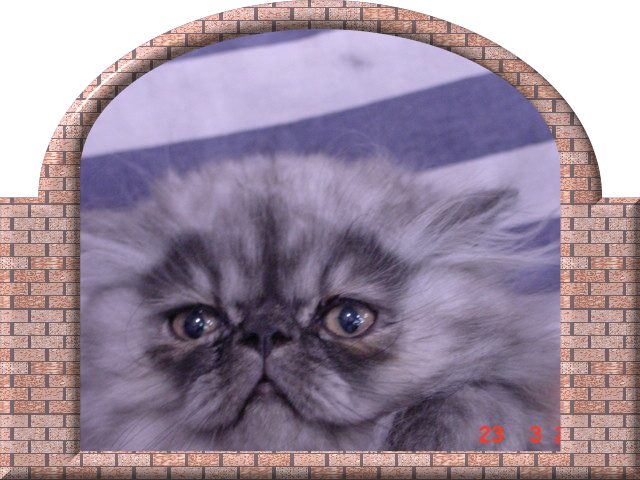
Magnika
Catstein Midore, (Frescati), black smoke male, carrying Chocolate &
colourpoint
Parents:
Platinum Db Gr Champion Duachell Dion & Jiachus Savanah

Kimaris
Fifi Trixibelle, pewter female Persian Parents:
Bronze Db Gr Champion Kimaris Fascinatin' Rhythm & Kimaris Cinderella Mi
Bella.

Champion
Magnika Igor Petrovsky, black smoke Persian, parents
Platinum Db Gr Champion Duachell Dion & Gold Db Gr Champion Kimaris
Thumbelina


| |

Origins of the Persian
The Persian is one of the most widely recognised and popular breeds in the
world - and one of the oldest.
As their name suggests, Persians originate from the country that was once
Persia, now Iran, in the Middle East.
Experts believe that today’s domestic cat is the descendent of Felis libyca,
a cat that is still found in Africa and Asia. A short-haired, brown mackerel
tabby, its adaptation to the environment caused many early mutations, one of
which was the development of the long-haired gene. The first of these cats, the
Persian, was believed to have evolved on the high, cold plateaus of the country
then named Persia, hence their name.
The cats were introduced into Europe by the Phoenicians and Romans in the
1500s as highly valued items of trade. The Europeans were impressed by the
Persian’s long silky coat and purposefully bred the cats to perpetuate the
trait. By the 1900s the cats were being exported to the United States and since
then their popularity has spread throughout the world.
The Persian is the most popular breed among the long-haired cats; others
include Birman, Turkish Van, Ragdoll, Mayne Coon, Norvegian Forest Cat and the
Exotic (short hair version of the Persian).
In Australia today, while Persians are still out-numbered by the short-haired
breeds, they continue to be popular as both a family pet and for showing
purposes.
The Persian is a medium to large cat with heavy bones and excellent balance
from section to section.

Different Types of Persians
While most of the Persians are of a similar size and shape, they can vary
dramatically in their coat and eye colourings.
Chinchilla is a white coat with black tipping all over and green
eyes. Here is the black tipping only on the edges, hardly visible.
Shaded silver has silver tipping on the edges of the hairs and has
green eyes. Has a bit longer black tipping on the edges.
Pewter is the same as a Shaded Silver but has copper eyes.
Silver Tabby has a tabby pattern which can be mackerel, classic,
spotted.
Black Smoke has half the hair black painted and the undercoat is
white-silver.
A Shaded Golden has a deep apricot undercoat against a black tipping
on the edges. The eyes must be green.
The above mentioned patterns come in Black, Blue, Lilac, Chocolate and
Golden.
Further, occasionally can be found brown tabbies, shaded torties and shaded
bi-colours.

A Placid and Laid-back
Temperament
Persians are generally placid, laid-back cats which make very loving pets.
Playful as young kittens, they become less so as they grow older. They have a
life expectancy of approximately 14 to 18 years of age.
Temperaments have been observed to vary slightly between the different
colours and varieties. The most placid cats are usually the Solid coloured ones,
whereas the Point (colourpoint) Persians tend to be more lively and are slightly
more vocal. Males and females make equally good pets.
They can be very easy going but at the same time boisterous as well when they
want a game: they like to play with objects like balls and things on strings.
Passive and adaptable, the Persian generally is not a lap cat but will be
content to stay a while for a pat and cuddle.
Persians love people and like the company of other cats.

Grooming: Start the Young
When seeing a Persian cat, a common reaction from people is “Oh. isn’t
that a beautiful cat?”. But keeping a Persian well-groomed takes time and
commitment from its owner.
Grooming is particularly important for long-haired cats such as Persians, as
their coats can become easily matted and snarled. Not only does a cat with a
matted coat look unkempt, the mats are uncomfortable for the animal as they pull
against the skin. This can lead to skin breakdown and the development of sores
and infections.
Most breeders recommend Persians to be groomed once a day, particularly when
they are moulting. They should also be bathed and blow dried once a month.
Many owners agree that they enjoy the time spent grooming their cats each
day, and how therapeutic it is to sit down and have that time together.

Requirements in a Home
Persians generally don’t need a lot of room as they’re not as active as
other cats. As such, they will easily adapt to living in a flat or unit. A
Persian is able to live indoors permanently provided it has essential toys, a
scratching post and litter tray available.
However, Persians love company and do not like to be on their own. If there
is someone home during the day and they have time to spend with the cat, then a
single Persian will be perfectly happy. If the owner works away from home it is
a good idea to have two cats as company for each other.

What Breeders Say
McCarthy: My first
Persian used to sleep in bed with me and act as my alarm clock. “Every
morning, she would gently pad my face with her paw to tell me it was time to get
up.”
Parcell: Yes, they are a bit of work, but they are certainly worth it for
all the love and affection you get in return.
Thorburn: “The most satisfying thing is delivering the kittens and
seeing what you’ve got, then watching them grow up”.
But probably the most endearing quality of owning a Persian for these
breeders is their sweet and affectionate natures.
Dr Harry Cooper: He used to comment on the therapeutic benefits of cats.
He is a breeder of short-hair cats, and he once said to Shirley “If ever I’m
down, I go and sit in our cattery and after half an hour of all the love and
affection you get, all your problems seem to disappear.”
Information is adopted from an article from Julia Lyons, "Pets and
Vets", issue 2, Feb-Mar 1998, Milton, Brisbane, Australia, pp 64-68.
|
